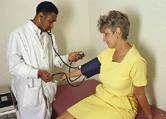
WEDNESDAY, Jan. 25 (HealthDay News) — People who reach midlife without developing high blood pressure, diabetes or other risk factors for cardiovascular disease are much less likely to have a heart attack or stroke by age 80 than their less healthy peers, a new study suggests.
“If you make it to middle age with an optimal profile, it’s really like the fountain of youth for your heart,” said lead researcher Dr. Donald Lloyd-Jones, chair of preventive medicine at Northwestern University Feinberg School of Medicine in Chicago.
Besides diabetes and hypertension, researchers looked at the effects of two other cardiovascular risk factors — high cholesterol and smoking — on long-term heart health. A heart-healthy profile at midlife “essentially abolished your remaining chance of developing any heart disease over your remaining lifespan,” Lloyd-Jones added. These lifestyle-related factors mattered more than age, race or sex, the researchers found.
Cardiovascular disease remains the leading cause of death for U.S. adults.
The researchers found that a 45-year-old man with optimal levels of those risk factors has a 1.4 percent chance of having a major heart event or stroke during his remaining lifetime, Lloyd-Jones said.
“Contrast that with a 45-year-old man who has two or more major risk factors, his lifetime risk would be 49.5 percent,” he said.
Similar numbers emerged for women, blacks and whites, he said.
But it’s a lifetime of healthy living that pays off, experts said.
“We need to do a better job of getting our children and young adults off to a healthy start so that more of them can make it into middle age with optimal risk factors,” Lloyd-Jones said. “All of these risk factors are preventable, or at least modifiable, by lifestyle.”
If you have some of these risk factors, it is critically important to get with a doctor and control them, and that’s likely to require medication and lifestyle change, Lloyd-Jones said.
But treatment only goes so far, he said. “It mitigates the risk, but it never really puts the horse back in the barn. It’s important to get treated, but it’s better to have never developed these risk factors in the first place,” he said.
The report was published in the Jan. 26 issue of the New England Journal of Medicine.
For the study, Lloyd-Jones’ team reviewed 18 studies that included a total of more than 250,000 people aged 44, 55, 65 and 75. They were looking for patterns that may not have been part of the original findings, but could lead to new conclusions.
Using the four cardiovascular risk factors, the researchers estimated the lifetime risks of cardiovascular disease, heart attack and stroke.
For individuals 55 years old having an optimal risk factor profile — low blood pressure and cholesterol levels, not smoking and not diabetic — the chance of having cardiovascular problems through age 80 was 4.7 percent for men and 6.4 percent for women.
Those with two or more risk factors had a much higher risk of cardiovascular disease — about 30 percent for men and 21 percent for women, the researchers found.
The risk for heart disease or heart attack was 3.6 percent for men and less than 1 percent for women with optimal profiles, compared to 37.5 percent and 18.3 percent, respectively, for those with two or more risk factors, they noted.
For stroke, an optimal risk profile reduced risk to 2.3 percent for men and 5.3 percent for women, compared with 8.3 percent for men and 10.7 percent for women with two risk factors, the researchers calculated.
Dr. Gregg C. Fonarow, a professor of cardiology at the University of California, Los Angeles, and a spokesman for the American Heart Association, said studies consistently demonstrate that blood pressure, cholesterol level, smoking status and diabetes status are key determinants of cardiovascular risk.
This new study also shows the lifetime cardiovascular risk is similar for white and black patients, he said. Moreover, at every age, more risk factors substantially increase the lifetime risk of cardiovascular disease, he added.
“Every adult, no matter how young or old, should be aware of their cardiovascular risk profile and take proactive steps to achieve optimal cardiovascular health,” Fonarow said.
A December report from the American Heart Association found that more than two-thirds of U.S. adults and about one-third of children are over the ideal body weight, and those extra layers of fat put a major strain on their hearts.
More information
For more information on heart-healthy living, visit the American Heart Association.

